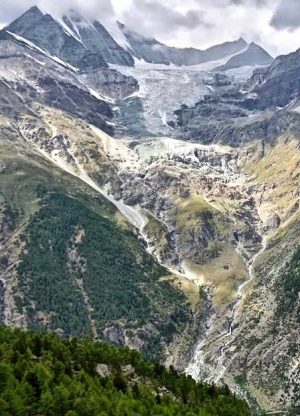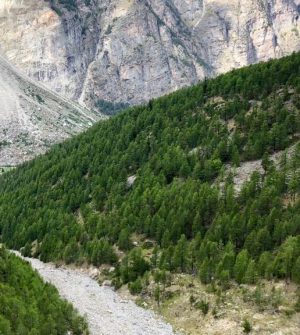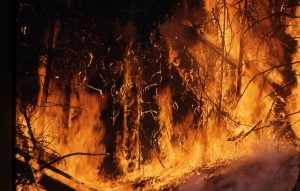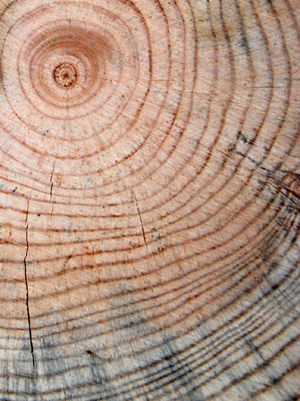Forests and woodlands in flux

Twelve thousand years ago (during the late glacial maximum) massive ice sheets and glaciers extended across much of the world. Then, the climate began to warm and about ten thousand years ago, our landscape started to look very different from today - not just because there were no roads, towns or cities but because the newly exposed land was being colonised by plants, trees, animals – and lastly by people.
The forests and woodlands that slowly developed in the post Ice Age period were different to the forests and woodlands that we see today. The land was colonised (at this time) by the plants and animals that lived on ‘the edge of the ice’. This colonisation included some trees and plants from “refuges” in different parts of continental Europe. Different species of trees thrived in different places, depending on climate, soil and altitude. For example, Scots Pine and Birch found a home in the Central Highlands, whereas Oak and Hazel (and Wych Elm) established in more southerly regions.
These forests and woodlands were ‘home’ to many bird and animal species some of which are no longer part of our native UK flora, for example, wolves, bears, aurochs, wild boar and lynxes (though beavers have been re-introduced in some areas very recently, and a recent report suggests that rewilding of bear and wolves may follow).
 In the immediate post Ice Age period from 9000 to approximately 4500 BC (the mesolithic period) human groups explored and settled in the lands and islands that became available. They were settlers in a landscape that had been transformed by the physical processes associated with glaciation, such as U-shaped valleys and corries in northern areas. Further south, terminal moraines (like the Cromer Ridge) formed as the ice melted; the glaciers dumped their rock debris, which had been picked up as they ground their way across the earth’s surface.
In the immediate post Ice Age period from 9000 to approximately 4500 BC (the mesolithic period) human groups explored and settled in the lands and islands that became available. They were settlers in a landscape that had been transformed by the physical processes associated with glaciation, such as U-shaped valleys and corries in northern areas. Further south, terminal moraines (like the Cromer Ridge) formed as the ice melted; the glaciers dumped their rock debris, which had been picked up as they ground their way across the earth’s surface.
Archaeological evidence indicates human occupation followed the retreat of the glaciers, Over time, these settlers interacted with the world at first through the exploration of new lands but in time they would form a detailed knowledge of their land, woodlands and climate. Their lives would be attuned to the seasonal availability of resources - in the woodlands, forests, rivers and the sea. They were essentially hunters-gatherers, and occasional fishers, who made extensive use of woodland resources. They used certain woods for particular tools such bows, coracles / canoes and paddles. Birch bark and willow were used to make baskets / containers. Hawthorn or apple was sometimes used to make the haft of an axe. Nettles were used as a source of fibre for twine / ‘rope’. 
Fire was probably used to clear areas of woodland. Charcoal has been found at archaeological sites, as have remains of acorns, crab apples and various plants tubers - which suggest the collection and gathering of food stuffs. Analyses of midden material at various sites reveal the remains of fish, bird and mammals. These would have provided high grade protein (meat) but also pelts and furs - for clothing and leather. As their clothes and belongings were made of organic materials (from plants or animals) they have left little in terms of remains.
Our woodlands and forests have now been in decline for several thousand years - largely because of human activity. Farming probably developed in the Near East (in the Fertile Crescent) and then spread across continental Europe. The people associated with this activity / lifestyle probably crossed the English channel around 4000 BC. They were the neolithic pioneers - who would effect a further transformation of the landscape of the British Isles.
Not  only did these people begin to clear woodlands (the wild wood) but the grazing activities of their cattle and sheep, [plus that of deer] affected the growth / survival of young trees thus limiting the natural regeneration of the woods and forests. The loss of woodland contributed to the disappearance of larger mammals from our fauna.
only did these people begin to clear woodlands (the wild wood) but the grazing activities of their cattle and sheep, [plus that of deer] affected the growth / survival of young trees thus limiting the natural regeneration of the woods and forests. The loss of woodland contributed to the disappearance of larger mammals from our fauna.
The clearance of woodlands and scrub allowed the farmers to grow cereals such as wheat and barley, and also flax - for its seeds and cloth making. The trees provided timber for fuel and the building of homes, timber halls and wood henges. A seahenge or timber circle has been found on the Norfolk Coast, created from large, upside-down oaks - their roots offered up to the sky. Dendrochronology (analysis of tree rings) indicates that this circle was created circa 2049 BC.  The existence of neolithic structures is sometimes revealed in aerial photographs in times of drought - when the circular patterns of henges etc can be seen.
The existence of neolithic structures is sometimes revealed in aerial photographs in times of drought - when the circular patterns of henges etc can be seen.
The population of the British Isles at the end of the Neolithic era (2500 BC) has been estimated at around 250,000 people. By the end of the Bronze Age (800 BC) it had probably doubled to about 500,000. As time has gone by, the population of the British Isles has continued to increase; it now stands in excess of 66 million.
As the population expanded so did farming and agriculture. Now nearly 70% of our countryside is devoted to farming / agriculture; even so the UK produces less than 60% of the food it needs. This changing pattern of land use is true across the globe and the Earth’s population is dependent on a very limited palette of staple crops (which is a concern) and we are currently witnessing the sixth major extinction of our flora and fauna.
Comments are closed for this post.

What is the best thing as individuals we can do to help this decline? Thanks
Harry Heath
5 September, 2019